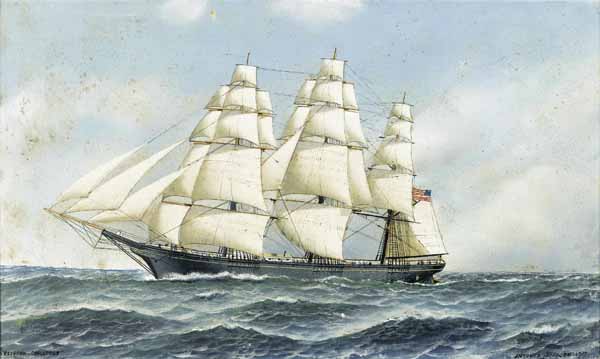The result took the clippers slicing through the oceans on runs that were, for their time, astounding and consequently newsworthy. In 1845, when the first “true” clipper, the American Rainbow, sailed to China and back in seven months, she was breaking every previous record for the run.
Record-Breaking Clippers
No wonder, then, that six years later, when the 232 ft. long, 1,783-ton Flying Cloud sailed from New York to San Francisco via Cape Horn in 89 days, 21 hours, the exploit hit the headlines.
This, though, was only the beginning. In 1853, the 939-ton Aberdeen-built Cairngorm made her maiden voyage from Lisbon in Portugal to Hong Kong in seventy-two days.
One of the few iron-built clippers, Lord of the Isles, accomplished a ninety-day tea run from Shanghai on the coast of China to London in 1858-1859. And the Cutty Sark and Thermopolyae beat the 96-day average for the wool run from Australia to London by 27 and 17 days respectively in 1887-1888.
Not all voyages, of course, broke existing records, and even the fastest clippers could belie their own potential and take well over one hundred days to complete a voyage.
The Unreliability of Sailing Ships
The Cutty Sark, for instance, was capable of seventeen knots when fourteen or fifteen knots was considered a good rate, even by demanding clipper ship captains. Yet even this superlative vessel, one of the fastest of all tea clippers, took 122 days on one China tea run and 127 days on another.
The disparity between these “slow” runs and the fastest passages revealed the one great drawback for trades which relied on sailing vessels. No one could forecast with any reasonable accuracy how long they might take to arrive at their destinations, or, indeed, precisely when they would arrive, since no one knew what adverse conditions and other hazards of the sea might intervene.
Sailing ships were known to be months late in arriving and while this built-in unreliability had to be endured when no alternative existed, attitudes began to change when that alternative finally made its appearance.
The Rise of Steam Power
Ironically, steam power, which rivalled and finally eclipsed the sailing vessel, had shadowed clipper development almost all the way.
In 1833, when the first small prototype clipper, the 500-ton Ann McKim, was built in Baltimore, the Canadian steamship Royal William, which had twin side lever engines of two hundred nominal horsepower, took 25 days on the first east-west Atlantic crossing made entirely under steam.
In 1845, when Rainbow opened the clipper ship era, Isambard Kingdom Brunel’s 9.3-knot Great Britain steamed on her maiden voyage from Liverpool in northern England to New York in a record time of just under fifteen days.
In the years that followed, steamships continued to demonstrate their greater reliability. This went with the fact that they were not only faster than sailing vessels, but could also maintain their speeds. This, of course, was something sailing ships could never guarantee.
The Suez Canal
The final coup de grace which heralded the end of the age of sail in favor of steam was the opening of the Suez Canal on November 17,1869.
Ironically, this was the same year in which construction began on the Cutty Sark, the most renowned of clipper ships. However, the statistic that counted most was the 7,350 miles and several weeks the Canal cut from the traditional passage around the African continent for the voyage between Europe to Asia.
An End to the Age of Sail
The age of steam did not, of course, replace the age of sail immediately and there was a brief period when sailing ships, including the clippers, were fitted with auxiliary steampower. The traditional wool clippers were still plying the Australia run in the 1890s.
But inevitably, they were the last of their breed. Together with the steam-assisted sailing vessel and a curious hybrid that combined a metal, instead of a wooden, hull with masts and sails these ships faded out of use and took the beauty and grace of the sailing ship era along with them.
Please see also: In the Last Days of Sail: Life on Board the Clipper Ships
Sources:
- Buchanan, R.A. Brunel: The Life And Times of Isambard Kingdom Brunel (London, UK: Hambledon & London, 2006) ISBN-10: 1852855258/ISBN-13: 978-1852855253
- Gardiner, Robert: Sail’s Last Century: The Merchant Sailing Ship, 1830-1930 (Conway’s History of the Ship) (New York, NY: Booksales, 2001) ISBN-10: 0785814167/ISBN-13: 978-0785814160








